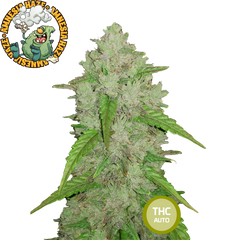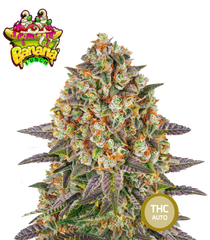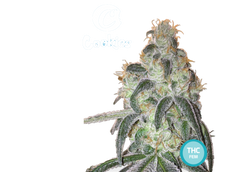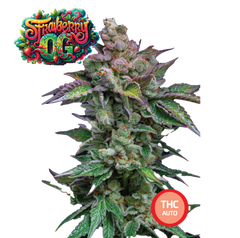
Complete Guide to Growing Cannabis Outdoors
Growing marijuana outdoors is a rewarding experience, whether you’re looking to harvest a quality crop for personal use or exploring the world of home growing. In this guide, we’ll provide you with everything you need to know to get started, from choosing seeds to growing outdoor plants , and how to manage your plants throughout the various stages of growth.
What are the advantages of growing cannabis outdoors vs. growing indoors?

Growing cannabis outdoors offers numerous advantages over growing indoors and in greenhouses . First of all, the use of sunlight allows plants to grow naturally, reducing the costs associated with electricity and the purchase of specific lamps. In addition, the outdoor environment offers an ideal day-night cycle, with temperatures and humidity that favor lush growth.
Another advantage is the freedom of space: outdoors, plants can develop without the limitations of a grow room , reaching larger sizes and producing a more abundant harvest than when growing indoors . However, growing hemp outdoors requires attention to climate conditions, soil quality and protecting marijuana plants from pests and animals.
It is crucial to have a good understanding of the climate in the area where you live. Cannabis is well adapted to a variety of climates, but is still sensitive to extremes. Sustained temperatures above 30°C will stunt the growth of your plants, while temperatures below 12°C could damage and stunt their growth , or even kill them. Heavy rain and strong winds could physically damage plants and reduce yields, and excessive humidity can lead to mold and mildew growth, especially during flowering.
In addition to climate change, you need to understand how the length of days varies in your area during different seasons. For example, at a latitude of 32°N (San Diego), there will be 14 hours of daylight during the summer solstice (the longest day of the year), while at 47°N (Seattle) there will be 16 hours of daylight on the same day.
A helpful resource is Sunset Magazine’s climate zone map , which takes into account a variety of factors, such as elevation and proximity to large bodies of water. Another good idea is to use local resources, as gardeners in your area will likely have a wealth of information about growing flowers and vegetables that can be applied to growing cannabis. If you have some experience with gardening and growing vegetables, you may also find that growing cannabis outdoors is a fairly simple endeavor.
How to choose seeds for growing cannabis plants?

Choosing seeds is a crucial step in successfully growing plants . There are several varieties of cannabis , including sativa , indica , and autoflowering . Autoflowering varieties are especially recommended for beginners, as they are more resistant and have a faster growth cycle.
Sativa strains are ideal for those with warm, sunny climates, as they grow tall and produce an energizing effect. Indicas , on the other hand, are better suited to cooler, more humid climates, with a shorter growth cycle and a relaxing effect. It is important to choose quality seeds from reliable sources and, if possible, certified seeds to ensure good germination and a healthy cannabis plant .
At our online shop you will find a wide variety of Feminized, Autoflowering and Fast Flowering seeds .
When is the best time for a grower to plant?

The ideal time to plant cannabis seeds outdoors varies depending on your local climate. In temperate regions, planting is usually done in spring, when nighttime temperatures don’t drop below 10°C. This allows the plants to use the entire summer season to thrive.
For a correct outdoor marijuana cultivation , it is essential to monitor the climatic conditions and predict any temperature variations, which could affect the growth and flowering of the plants. It is possible to germinate the seeds indoors and transplant them outdoors when the climatic conditions are optimal, thus ensuring a better survival of the young cannabis seedlings .
How to prepare the soil for indoor or outdoor home growing?

Soil is one of the key elements for the success of outdoor cultivation . The hemp plant requires well-drained soil, rich in nutrients and with a pH between 6 and 7. If the soil in your garden does not meet these requirements, you can improve it by adding organic compost, perlite and other natural amendments.
The soil is made of three basic components, in various quantities:
- Clay
- Sand
- Silt
Cannabis plants need well-drained, slightly acidic soil that is rich in organic matter to thrive. If you decide to plant directly in soil, you need to first understand what it is made of and amend it accordingly.
Clay soils dry out slowly and do not retain oxygen well, so they will need lots of additives. At least a month before planting, dig large holes where you will place your cannabis plants and mix in large amounts of compost, manure, worm castings or other decomposed organic matter. This will provide aeration and drainage, as well as nutrients for the plants.
Sandy soil is easy to work with, drains very well, and warms up quickly, but it doesn’t hold nutrients well, especially in rainy environments. Again, you’ll want to dig large holes for your plants and add things like compost, peat moss, and coco coir, which will help bind the soil together, providing food and air circulation. In warm climates, sandy soil should be covered with mulch to help retain water and keep the roots from getting too hot.
Silty soil is ideal for growing. It is easy to work, warms quickly, holds moisture and drains well, and contains many nutrients. The best silty soil is found in prehistoric river beds or at the bottom of lakes. This dark, crumbly soil is the most fertile, and will require very few additives.
If you want to ensure you get good results and minimize headaches, you can have your soil tested, which is easy and relatively inexpensive. A soil testing service will tell you the composition and pH of your soil, tell you about any contaminants, and will direct you to suitable additives and fertilizers.
Choose a Location for your Marijuana Seedlings

Location is equally important. Cannabis plants need at least 6-8 hours of direct sunlight per day to thrive and produce abundant THC and CBD . Avoid areas that are too exposed to wind or have too much shade.
Choosing the right location for your garden will be the most important decision you make, especially if you are planting in the ground or in large fixed containers (some plants grow outdoors in containers that can be moved depending on the weather and the position of the sun). Your cannabis plants should receive at least 5 to 6 hours of direct sunlight each day, ideally in the middle of the day when the light quality is best.
If you live in an area where daily temperatures are consistently above 85°F (30°C), you should choose a spot that receives direct sunlight early and filtered light during the hottest parts of the day. An area with a steady breeze is a good choice in warm climates, although this will increase water usage. On the other hand, if you live in an area with a lot of strong winds, you should consider planting near a windbreak of some sort, such as a wall, fence, or shrubbery. Those in cooler climates may benefit from planting near something that retains heat, such as a south-facing brick wall or fence, while those in warmer climates will definitely want to avoid these spots.
Finally, you will want to consider privacy and security. Many people will want to hide their gardens from questioning neighbors and potential thieves. High fences and large bushes or trees are best unless you live in a remote area. Some people plant in containers on balconies or rooftops, hidden from view, while others build large diameter wire cages to keep thieves and animals at bay. Whatever you decide to do, remember that outdoor cannabis plants can grow 12 feet or more tall, so plan accordingly.
What are the flowering and growth stages of cannabis cultivation?

Growing cannabis outdoors involves several stages of growth, each with its own specific needs. During the vegetative stage , plants focus on growing leaves and branches, storing energy for the subsequent flowering stage . During this stage, it is important to provide plants with adequate nitrogen and ensure good exposure to sunlight.
The flowering phase usually begins at the end of summer, when the days start to get shorter. During this phase, the plants develop inflorescences, rich in cannabinoids such as thc and cbd . It is essential to carefully monitor the humidity level and prevent the attack of pests and mold, which could compromise the harvest.
How to protect your outdoor cannabis grow from pests and diseases?

Growing cannabis outdoors also means dealing with pests and diseases that can attack your plants. Common pests include aphids, spider mites, and caterpillars, while fungal diseases, such as gray mold and powdery mildew, can compromise the health of your plants during the flowering phase .
To prevent these problems, it is advisable to adopt organic growing techniques , using natural insecticides such as neem oil and ensuring good air circulation between plants. It is also important to regularly inspect plants and remove any infected leaves or parts.
Autoflowering or Photoperiod: Which Strain to Choose?

Autoflowering cannabis plants are a popular choice for outdoor growing , especially for those living in climates with short summers. These plants flower automatically after a set period of growth, regardless of the light cycle, and are usually ready to harvest in about 8-10 weeks.
Photoperiod strains, on the other hand, require a specific light cycle to enter the flowering phase . This makes them better suited to climates with long summers, where they can make the most of natural sunlight. Photoperiod plants tend to be larger and produce larger yields than autoflowering strains , but they require more attention and care.
How long does it take to grow cannabis outdoors?

The time it takes to grow cannabis outdoors varies depending on the strain you choose and the climate conditions. Autoflowering strains are ready to harvest in about 2-3 months from seed, while photoperiod strains require a longer growing period, which can be up to 6 months.
During this period, it is essential to carefully monitor the plants, providing them with the water and nutrients necessary for healthy growth. The flowering phase is particularly delicate, as it directly affects the quality and quantity of the final harvest.
When and how to harvest outdoor-grown cannabis?

Harvest time is one of the most exciting times in cannabis cultivation . To know when is the right time to harvest, it is important to observe the trichomes, the small glands that produce cannabinoids such as thc and cbd . When the trichomes take on a milky, amber color, the plant is ready to be harvested.
Harvesting should be done carefully, using clean, sharp scissors to cut the branches. Once harvested, the buds should be dried in a dark, well-ventilated environment for at least 1-2 weeks, before moving on to the curing stage, which improves the flavor and potency of the final product.
Is it legal to grow cannabis outdoors?

Cultivation of cannabis for personal use is regulated by specific laws in many countries. In Italy, cultivation of cannabis is legal only for certain varieties of industrial hemp with a THC content of less than 0.2%, and must be done using certified seeds .
For those who want to grow cannabis sativa for therapeutic purposes or for personal use, it is necessary to inform yourself about local regulations and, if possible, obtain the necessary authorizations. Home cultivation without the necessary precautions could be considered illegal and lead to criminal penalties.
Conclusion
Growing cannabis outdoors is an art that requires patience, dedication, and a good dose of knowledge. By following the tips provided in this guide, you can grow healthy, thriving plants that can provide you with a quality harvest without running into legal issues or common mistakes. Always remember that the key to success when growing cannabis outdoors is careful planning and daily plant care. Whether you are a beginner or an experienced grower, growing cannabis outdoors can be extremely rewarding, allowing you to connect directly with nature and appreciate the fruits of your labor.
Final tips for successful outdoor growing:
• Constantly monitor the natural cycle of your plants, from the vegetative phase to the flowering phase .
• Choose your soil type carefully and provide your plants with the nutrients they need for healthy growth.
• Protect your plants from pests, diseases and unexpected weather changes.
• If you are a beginner, opt for autoflowering strains that are easier to manage.
• Harvest at the right time and scrupulously follow the drying and tanning phases to obtain a quality product.
Finally, remember to always inform yourself about the laws in force in your country to grow safely and without incurring legal problems.

















